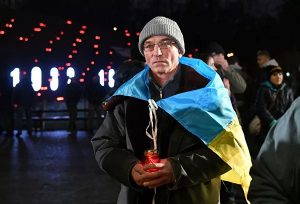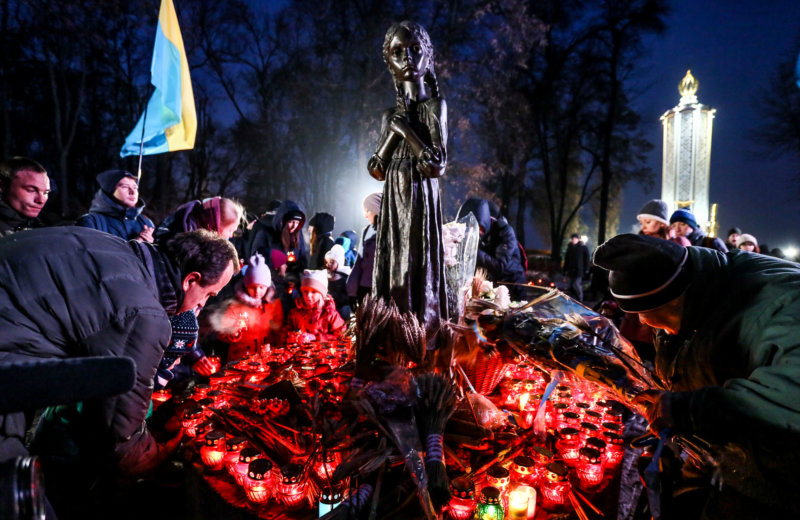Kuva: Ukrainians light candles and place flowers during the memorial ceremony near a monument to the victims of the Holodomor, a man-made famine of 1932-33 under Soviet totalitarian Josef Stalin. on Nov. 24, 2018. Photo by Oleg Petrasiuk
Tässä on nyt kuitenkin ukrainalainen lähde, joka ensinnäkin paheksuu käännettä, ja esittää sen yksipuolisessa valossakin. Kysymys ei ole vain siitä, ettei Saksan Perus-tuslakituomioistuimen ja EIT:n ”omiin” oikeusperiaatteisiin kuulu takautuva tuomio myöhemmin säädetystä rikostyypistä (vaan olisi joukko erillisiä henkirikoksia, jat- kettuja murhia eri paikoissa), vaan myös siitä, ettei YK ole tällaista koskaan toden- nut eikä tulekaan toteamaan, ja esimerkiksi Ranskan Perustuslakituomioistuin onkin sitten suoraan sidoksissa YK:n Peruskirjaan (maan omilla päätöksillä). YK:n laissa ei ole ehdotonta takautuvan tuomion kieltoa. Noiden välillä ei voi ”surffata” lause kerrallaan.
https://www.kyivpost.com/ukraine-politics/german-foreign-ministry-oppose…
” German foreign ministry opposes petition to recognize Holodomor as genocide
By Artur Korniienko.
Published Oct. 22 at 6:21 pm
Germany’s Federal Foreign Office opposes a petition to recognize the Holodomor, the Soviet manmade famine that killed roughly 4 million Ukrainians in 1932 – 1933, as genocide, according to Arnold Vaatz, a lawmaker with Germany’s ruling Christian Democratic Union party.
“The Foreign Ministry wants the petition to be rejected on the grounds that the concept of genocide was not defined until 1951,” Vaatz told the Ukrainian office of Deutsche Welle, the state-owned German broadcaster, in an interview on Oct. 21.
Vaatz says it’s a dangerous argument because supporters of National Socialism could demand the revaluation of Adolf Hitler’s genocide in the 1940s on the same grounds.
“In my opinion,this argument is very technocratic”,Vaatz said.“The same applies to another argument that, besides Ukrainians, this artificially arranged famine had other victims in Russia and the Caucasus, in particular. This argument, in my opinion, also seems more like an excuse.”
Vaatz is a member of the petition committee in Germany’s Bundestag, which discussed the petition at an open meeting on Oct. 21, 2019 after hearing the Foreign Office’s evaluation of the document. The Committee consists of 28 lawmakers from different parliamentary factions.
Next, the petition committee will either ask the Foreign Office to implement the petition or reject it. Vaatz says that rejection is more likely be- cause of the Foreign Office’s opposition to it. Either way, parliament will vote on the committee’s decision, and it will likely be included in a package of other proposals.
“I think this (rejecting the petition) is wrong. Colleagues who think the same way will likely apply to vote in favor of this petition in the Bundestag as a separate item. But probably there won’t be a majority to adopt this petition in the Bundestag,” Vaatz says.
A similar petition has already been rejected by the petition committee in 2016 after the Foreign Office opposed it on similar grounds. At the time, the Christian Demo- cratic Union (CDU), which was more welcoming to the petition, had even more seats in the parliament. In the cur- rent convocation, the CDU is opposed by the Alternative for Germany party, which supports lifting sanctions on Russia and will most likely vote against the petition.
The committee will now process what was discussed at the open meeting. Vaatz thinks that the issue will be put on the Bundestag’s agenda this year.
The petition was registered in December 2018 and collected the required 50,000 signatures before the May 27 deadline. It now has over 56,000 signatures. Citizens of any country could sign the petition.
“This was not an ‘ordinary famine’ caused by crop failures, weather disasters or such. It was a crime – an artificial, organized famine that had cost tens of millions of Ukrainian lives and starved a nation of farmers. This inhumane and monstrous act was ordered by Josef Stalin, who wanted to break the resistance of the rural Ukrainian population against forced collectivization and aimed at destroying the cultural and religious life of Ukraine,” the petition says.
Nataliia Tkachuk, a Ukrainian activist living in Germany, initiated the petition. Ukraine’s Ministry of Foreign Affairs and diplomats, including former Foreign Minister Pavlo Klimkin, have promoted the signing of the petition.
“Friends, our moral obligation to the millions of innocent victims of the Holodomor is to let the memory of them and the tragedy of the Ukrainian people live in the world. The world should know the truth about the bloody, cannibalistic crimes of the Soviet regime in order to be able to respond to the modern displays of Stalinism that the present Russian authorities cherish,” Klimkin said on Facebook in April.
The U.S.House of Representatives and Senate both unanimously recognized the Holodomor as genocide of the Ukrainian people in 2018. Twenty-three U.S. states have also adopted such resolutions.
Besides the U.S., the Holodomor had been recognized as genocide by 15 countries, including Australia, Canada, Estonia, Hungary, Mexico, Poland and the Vatican. ”
https://www.pirkanblogit.fi/2017/risto_koivula/ukrainan-jarjestetty-nalanhata-jenkit-nato/
”Ukrainan järjestetty nälänhätä”, jenkit, NATO …
Nämä versiot EIVÄT muodosta etenevän tiedon sarjaa, edellinen ei sisälly seu- raavaan (parempaan!) ”kumoutuneessa muodossa”, kuten dialektikko edellyttäisi tieteeltä, vaan nämä eri ”teoriat” kumoavat toisensa muodollisloogisesti. Viimeisin on tieteelliseltä kannalta tyhmin.
Venäläiset ovat kumma kyllä salailleet aina näihin päiviin asti nimenomaan tietoja, jotka osoittavat ”kansanmurhateoriat” varmasti vääriksi!
Väestötiedot eivät kerro selittämättömistä joukkotuhoista.
… ”
Tämä saattaa olla osa diiliä, jolla Venäjä palasi mukaan Euroopan Norsunraatoneuvoston Parlamentaarisen kokouksen toimintaan – ja Ukraina vetäytyi sieltä pois…
***
Natsipiirit levittivät jo 1935 ainakin yhtä holomoottorijuttua.
https://www.stalkerzone.org/a-canadian-lecturer-is-being-persecuted-for-debunking-the-ukrainian-holodomor-fairytale/
A Canadian Lecturer Is Being Persecuted for Debunking the Ukrainian “Holodomor” Fairytale

Telling the truth about the famine of the 1930s, known in Ukraine as “Holodomor“, becomes dangerous not only in Ukraine itself.
Historical discussion about this difficult period of history of our country (and, recall, the famine touched many republics of the Soviet Union) has long been effectively banned. As early as 2006, the Verkhovna Rada passed a law imposing the term “genocide” on the famine. And since then there have been repeated attempts to criminalise the denial of that definition.
Various authorities, including law enforcement, have effectively banned any alter- native opinion. For example, in 2008 the-then head of the SBU Valentin Nalivay- chenko demanded the closure of the Ukrainian branch of the Institute of CIS countries for organising a scientific conference in Kiev, during which scientists from different countries dared to deny the theory of “genocide of the Ukrainian people”. So Ukraine will not be surprised by the ban on the freedom of scientific discussion about the famine of the 1930s.
But now the repression is spreading to abroad. The first foreign victim of “Holodo- mor” totalitarianism may become the Canadian historian and University of Alberta lecturer Dougal MacDonald. His fault is that he posted in a closed Facebook group, limited to a rather narrow circle of his colleagues and students, an extract from his own article about the origins of the myth that the famine of the 1930s was the artificial “genocide of the Ukrainian people”. No one would’ve noticed this post if the Ukrainian Student Society of the University had made it public, in an ultimatum demanding that the University take tough measures against the lecturer.
What was so terrible about the statement made by the Canadian teacher, causing a storm of emotions? He re-posted part of his small study published as early as 2015 in a bulletin of the Communist Party of Canada (Marxist-Leninist), of which he is a member. Based on the facts, MacDonald argues that the myth of “genocide” was built by Hitler’s Nazis “to discredit the Soviet Union, the enemy they most feared”. “The Nazis published articles on the front pages of German newspapers, which were then reprinted in the reactionary British press,” says the Canadian lecturer.
In particular, he recalls that the information about millions of deaths in Ukraine has been distributed worldwide since the publication of the American newspaper “Chicago American” in February 1935 (when the famine was no longer). On the front page it published an alleged “exclusive report” by journalist Thomas Walker entitled “Six million perish in Soviet famine”. In fact, since then, this number of deaths has appeared in many myths spread by Ukrainian propaganda. Moreover, doubts are caused by the photos brought by Walker and if he was even in Ukraine at all. In any case, he mentions settlements there with the names “Tambov” and “Veronezh”. It is also undeniable that both Walker and some of his other colleagues who were the first to write in the English-language press about the “genocide of Ukrainians”, visited Nazi Germany more than once and praised its chiefs.
McDonald suggests on this basis that the legend, like the fake photos, was made in Germany. He also recalls that the notorious newspaper “Chicago American” be- longed to American millionaire William Hearst, who for many years had praised Italian fascists and German Nazis, and who had personally met Hitler and Goebbels. According to MacDonald, it was at this meeting that Hearst concluded a contract on the PR promotion of Nazi propaganda in the American media, which resulted in Walker’s first-hand sensation of “six million famine deaths”, which formed the basis of the myth of “genocide”.
MacDonald points out that in Britain another yellow newspaper, the Daily Mail, the owner of which (Lord Rothermere) was also a fan of Mussolini and Hitler, was the first to rush to spread the myth of “genocide”. “Herr Adolf Hitler, the German Chancellor, has saved his country,” this newspaper happily trumpeted after the “Night of Long Knives”. But this did not prevent many researchers from referring to the materials of such a press about famine in the USSR.
It is no secret that the Goebbels press of occupied Ukraine inflated this myth. And the works about famine, which the Nazis actively distributed as propaganda, are now studied in Ukrainian schools almost as historical textbooks. For example, the cannibalistic novel “Mariya” by Ulas Samchuk, published in the Nazi newspaper “Volyn” in 1941, in which the same Samchuk glorified Hitler and rejoiced at “Kiev’s cleansing of the eastern barbarians”, describing the tragedy of Babi Yar.
I.e., MacDonald certainly did not exaggerate the importance of Nazi propaganda in inflating the scale of the Soviet famine of the 1930s and the associated “genocide” myth. However, this does not stop the organisers of the harassment of the Canadian lecturer. At the University of Alberta there are protests against him. The campaign was even joined by Alberta Provincial Prime Minister Jason Kenney, who made it clear that MacDonald was a “useful Communist idiot”, and expressed outrage that “some people in Canada still deny genocide”.
The quintessence of all accusations against, and attacks on, the lecturer was an article by Jars Balan, director of the Canadian Institute of Ukrainian Studies, under the title “No alternative facts about Ukraine’s Holodomor”. According to the author, the research into the causes and extent of the famine has already been done, and therefore alternative conclusions are simply unacceptable. And any attempt to direct people towards other facts that do not fit into the official concept amounts to “fake news”. At the same time, it does not matter whether these facts are true or not. The alternative is simply not allowed. Balan gives a list of publications about the famine that should be believed, effectively cutting off the opportunity for further scientific research. Not to mention if they reveal falsifications of Ukrainian historians and propagandists.
Timid voices about academic freedom and about the need to continue scientific discussions drown in the noise of protests against, and the harassment of, a Canadian scientist. It’s hard to tell if he will be fired in the end or not. But there is no doubt that fanatical followers of the “Ukrainian genocide” theory will create conditions for MacDonald in which he will not be able to conduct normal teaching activities. Perhaps not only at his university, but at any other university in Canada.
Thus, any scientific research regarding the Ukrainian famine of the 1930s is a priori driven underground already in the West. If you do not repeat the prepared propaganda theses (as we see, generated also by the Goebbels media), you will be harassed, discredited, and deprived of the opportunity to teach. And the truer your conclusions, the stronger and more powerful you will be swept aside. A modest Canadian lecturer was convinced of this via his own experience.
Vladimir Kornilov

